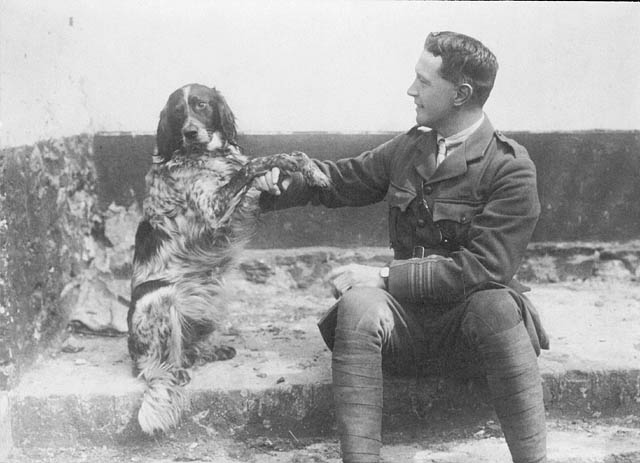By Taryn McIntosh
A Night in Flanders is an original one-act play by local playwright Donald Macrae, commissioned by Guelph Museums and held in the backyard of McCrae House, the historical site and childhood home of Sir John McCrae.
I arrived at McCrae House and took some time to look around before heading to the backyard. As I wandered through the museum and read about John McCrae, I realized that he grew up in this building, that it was the actual home of the McCrae family. The tragedy he witnessed, the mental anguish he experienced and the danger he was in seemed to contrast harshly with the sheltered innocence of the family home. I went out to the backyard and took a seat. I was the youngest audience member by decades and became conscious of my youth immediately. It is likely that most of the audience had heard stories from WWI directly from a family member, so it would be more natural for them to put an actual person in the situation and connect with it emotionally. My life looks very different from life during the war, so it takes more effort for me, and for many other young people, to connect on an emotional level to the information. Also, I was learning about John McCrae in primary school and reciting In Flanders Fields much before I understood the context or grasped the meaning. In this way, John McCrae had become a name, an idea, rather than an actual man.
I studied the recreated trench and backyard from my seat. As I looked around at the trees, I realized that they were the same trees that John McCrae would have seen as a child. It was disturbing to see the trench sitting in what was once the McCrae family’s backyard. In a strange way, I was glad to feel negative emotion, however. I considered the lack of emotion in the ways we look at history, and the cold way it is sometimes presented, especially to young people. War is disturbing, it is brutal, and it doesn’t make sense. Many people have had, and continue to have, their innocence taken by war.
The WWI-era music stopped, and the sounds of a battlefield played. John McCrae walked down the aisle between the seats and entered the trench. He poured himself a drink in a small container and sat down, toasting his friend, Alexis Helmer, who was killed and buried the day before. He fell asleep to “reawake” in a dream state. He began to speak about his life to “whoever might be listening”. The play ends with the writing of his famous poem, In Flanders’ Fields.
I was taken aback at first by how animated the actor was, expecting a more somber approach. However, it is important to reach a large audience with artwork that is also educational. The light approach allows people who want to learn about WWI and McCrae to have the opportunity to do so without worrying about gory or gritty war scenes.
In fact, the play is quite funny at times. One of the quirks that John McCrae had (based on research by the writer) was a book of curse words that he kept through his adulthood. Inside he wrote every unique use of profanity he heard in his encounters for his personal use when he was angry (though none of them are in the play). The comedy provides a respite from the otherwise heavy content.
Before seeing the play, I knew of John McCrae as a doctor, motivated by his passion to heal others. During the play however, I found myself connecting with John McCrae as a writer. I thought about the possibility that he was motivated to take part in the war, in some way, as a person who was passionate about creating documents. Journalists and poets are imprisoned and killed every day for the work they do. People document for the sake of history, justice, or remembrance, and sometimes their passion will drive them into dangerous situations. Regardless of whether it was his intention, John McCrae created one of the most poignant and unique documents of WWI. Moreover, In Flanders Fields captures emotion, which is a rare and important supplement to historical understanding. Whether we acknowledge it or not, human psychology and emotions are a part of history and need to be considered. However, it is often difficult or painful to reconcile human psychology with brutal events that are too horrific to imagine. I think it is important to feel the negative emotions out of respect to those who experienced it firsthand. I had a sense that this was one of the reasons the museum chose to present this play.
Just before leaving, I went into the garden beside the house to see the poppies and reflect for a moment. The sun was setting in the clear sky, and the temperature was perfect. The monument and little garden full of poppies are beautiful, especially in summer. Their petals are so brightly and deeply pigmented, I could only imagine their contrast with the mud and grit of the battlefield and the white crosses.
Poppy seeds can lay dormant under the soil for a long time, but disturbance of the ground can cause them to germinate. The digging of graves and destruction during battle would have disturbed the fields enough for the seeds to come closer to the surface, and the poppies would have arrived unexpectedly as the fields had previously held crops.
The juxtaposition of the poppies and the graves, of beauty and the ugliness of war, felt like a parallel to John McCrae’s poem. He created a beautiful work of art out of the tragedy and pain he experienced.








